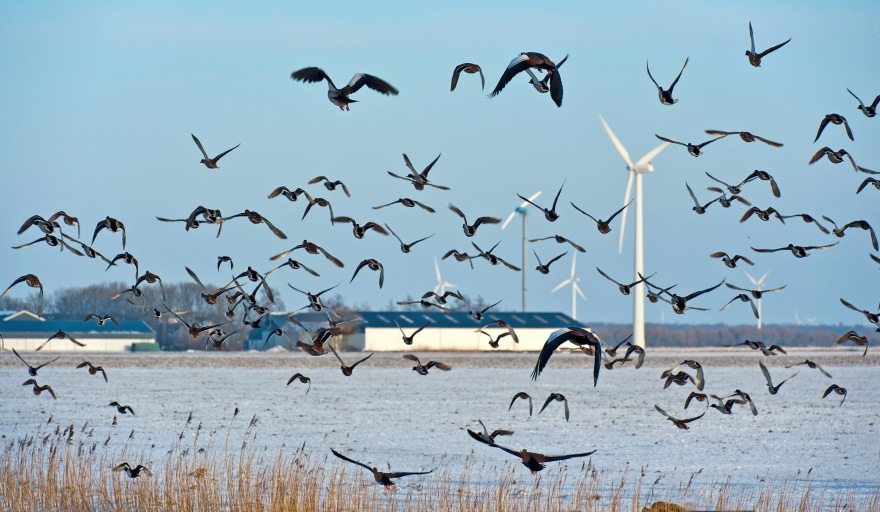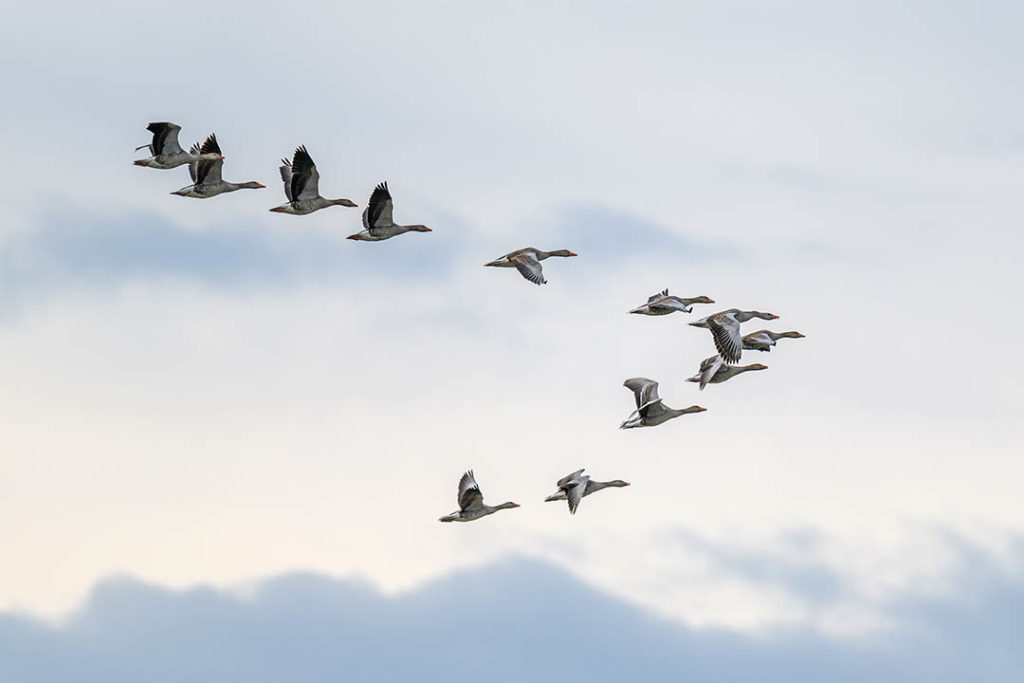When Do Birds Migrate? What The Science Tells Us
Last Updated on

Seeing birds fly south is a sure sign that the seasons are changing and winter lies ahead. Likewise, when you wake up in those late winter mornings to the sound of chirping, you know that warmer days are around the corner. In North America, birds head south in the late summer and autumn months and return in the early spring.
Avian migration is one of the greatest miracles of mother nature, allowing these incredible creatures to fly massive distances across the world. Migratory birds put the navigational skills of most humans to shame despite our use of technology. These birds don’t migrate randomly1, and they don’t cross these incredible distances for no reason, either.
Why Do Birds Migrate?
Birds migrate for a few reasons. It is widely assumed that migratory birds participate in this annual journey simply because it is warmer down south. The temperature may be a factor, but there are still many birds that don’t migrate at all. While temperatures may influence the birds’ migratory patterns, that is not because of a desire to be warm
The relationship between temperature and migration is usually related to resources like food and nesting grounds. As the temperatures drop and their food sources dwindle, they have learned to adapt and go where the food is. Other reasons include finding nesting locations and cover from predators.
There are also several kinds of migrations, including longitudinal, lateral, and elevational.
Elevational, or altitudinal, migrations would be like a bird going up a mountain in the summer rather than down south for the winter. There are many types of migration2, and not all are correct or intentional. A reverse migration occurs when birds head in the wrong direction. Birds tend to migrate along common corridors known as flyways. These flyways cover most of the globe—let’s show you what we mean.

North American Bird Migration Patterns
In North America, birds fly through four main migratory flyways. In order from west to east, the first is the Pacific Flyway, which stretches from Alaska to Patagonia and essentially hugs the continent’s western coast. American Robins, Fox Sparrows, and various types of thrush are a few types of pacific flyway birds.
Next, we have the Central Flyway. This is a vast corridor that stretches from the North Pole and follows the plains on the eastern side of the Rockies down into Central and South America. As for bird species of the central flyway, you’ll find both the Sandhill and Whooping Cranes, as well as McCown’s Longspur
using this route.
The Mississippi Flyway is the next migratory pattern that lies directly to the east of the Central Flyway. It runs from the Arctic regions of both ends of Hudson’s Bay and down across the Great Lakes. It then follows the mighty Mississippi River to the Gulf of Mexico, through the Caribbean, and into South America. You’ll find a lot of waterfowl along this route.
Finally, as you have likely guessed, the Atlantic Flyway traces the coastline of the Americas. The Canada Goose, American Black Duck, and Redheads are all waterfowl species that follow this route.
Afro-Eurasian Migration Patterns
Just as birds in North America migrate south for the winter, so do their European cousins. With that said, they don’t make the flight over to South America. Instead, they go to Africa. Like their North American counterparts, they tend to follow common corridors, which form flyways. While the continents that form the Americas are longitudinally long and narrow, Eurasia is very wide. With that said, the flyways of Afro-Eurasia are more easily defined by where they cross in Europe, Asia, the Middle East, and Africa.
It’s also worth noting that there is an Eastern Atlantic Flyway, which is a circular migratory pattern followed by oceanic birds. This covers Greenland and the Nordic countries, the East coast of North America, the British Isles, and the western coastline of Europe.
There is also a crossing from Spain to Morocco. This flyway covers from the Baltic region, down across Western Europe and the British Isles, and into the coast of West Africa. East of that lies the flyway which crosses between Italy and Tunisia. This bottleneck is fed on each side by massive land areas and looks like a giant hourglass covering Africa and Eurasia.
Next are our Eastern-European and Middle-Eastern avian flyways, of which there are only two. They cross from Israel to Egypt and from Yemen to Eritrea along the North-Eastern coast of Africa.

Australasian and Western Pacific Bird Migration Patterns
We’ve covered most of the globe, bringing us to the Australasian and Western Pacific flyways. There are three remaining land-based corridors. The first of the three includes the Central Asian-Indian Flyway, stretching from the Siberian Arctic to the Indian Ocean.
The East-Asian-Australasian Flyway covers the Eastern coastline of Asia, the Pacific Islands, and Australia. This may cover a massive stretch of our world, but the route which holds the longest migration on earth is the Western Pacific Flyway. It stretches from Alaska and the Bering Strait across the Pacific Ocean and down to New Zealand and parts of Australia. So, which bird species is tasked with the longest migration on the planet?
What Is the Longest Bird Migration?
The titleholder for the longest distance covered during seasonal migration belongs to a beautiful seabird. The gorgeous gray and white Arctic Tern travels from Alaska to New Zealand and back. That’s a long flight even if you have a recliner, meal, movie, and a pilot to do all of the work. This little bird makes the trip with no stopovers.
The total distance of this flight is approximately 7,511 miles! This bird also sees more sunlight than any other—which would make sense. In its 30-year lifespan, the Arctic Tern will fly approximately 15,000 miles a year. How does it cover so much ocean mileage without rest?
Can Birds Sleep While Flying?
Yes, some birds can fly while sleeping. Different species have different ways of going about this. An albatross can sleep while flying, but only for a few seconds at a time. Other birds have evolved so that half of their brain keeps them gliding and aloft while the other half gets some rest. It’s remarkable what these birds can do.

Do Birds In the Southern Hemisphere Fly North?
It would make sense, right? The Antarctic is surely cold enough that birds would flock to the warmer regions of South America or Africa for better, more abundant resources—or so you would think. However, it turns out that migration is most common in the Northern Hemisphere.
That’s not to say that birds in the Southern Hemisphere don’t migrate—they do.
What they don’t do is follow flyways in the same annual and predictable fashion that their cousins in the Northern Hemisphere do. This is a combination of geology and less predictable weather patterns. Birds in the Southern Hemisphere follow resources, but they tend to be more nomadic by nature.
Do Penguins Migrate?
We tend to think that migratory birds fly everywhere, but remember that not all birds fly. Even those that can’t soar the skies still manage to migrate. Penguins from Antarctica can be found in New Zealand and Australia. While you can see penguins in South Africa, they are actually from islands along the Western Coast of Africa and are called African Penguins!
For a long time, scientists were aware of another kind of penguin that migrated (the Emperor Penguin), but they didn’t know where they went. It’s been discovered through tracking bands that they like to head off to cold waters in the Pacific since these birds aren’t fans of the heat.

What Can We Learn From Bird Migrations?
As scientists study and learn about bird migrations, they also learn about our environment, which is the main factor in the decision to migrate. As these patterns change, we are learning more about the effects of our changing climate. Birds travel all over the world at impressive distances, and the times that they are moving can vary between species.
Featured Image Credit By Marijs, Shutterstock
About the Author Robert Sparks
Robert’s obsession with all things optical started early in life, when his optician father would bring home prototypes for Robert to play with. Nowadays, Robert is dedicated to helping others find the right optics for their needs. His hobbies include astronomy, astrophysics, and model building. Originally from Newark, NJ, he resides in Santa Fe, New Mexico, where the nighttime skies are filled with glittering stars.
Related Articles:
What Is the Best Binocular Magnification for Hunting? Optical Features Explained
Can You Use Binoculars to Look At Stars? How to Choose the Right Pair
10 Types of Hummingbirds in Arkansas (With Pictures)
8 Types of Hummingbirds in Nebraska (With Pictures)
5 Types of Hummingbirds in Idaho (With Pictures)
3 Types of Hummingbirds in Mississippi (With Pictures)
8 Types of Hummingbirds in Kansas (With Pictures)
5 Types of Hummingbirds in West Virginia (With Pictures)
